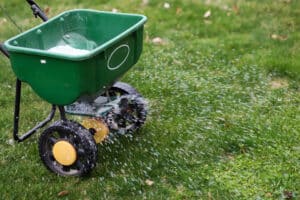Dealing with weeds in your yard can be frustrating, especially when it feels like they’re taking over. If your lawn is mostly weeds, there’s likely an underlying issue allowing them to thrive. Simply removing the weeds isn’t enough—you’ll also need to improve your lawn’s overall health to achieve the thick, green grass you want.
For a few scattered weeds, manual removal can be effective as long as you extract the entire root. However, if weeds have taken over your lawn, a more strategic approach is necessary. This guide will walk you through the steps to restore a weed-filled lawn, and if you need extra help, we’ll also recommend our top professional lawn care company to help you keep your grass weed-free.
Find Lawn Help
- See our list of top lawn care companies based on in-depth research.
- Select the company that best meets your needs.
- Get a free, no-obligation quote for your home.
Get a Quote From Lawn Professionals Near You
Compare quotes from local pros
Clicking “Get Your Estimate” submits your data to Home Service Quotes, which will process your data in accordance with the Home Service Quotes Privacy Policy.

Lime Soil Amendment

Lawn Fertilization
Why Is Your Lawn Full of Weeds?
It’s a good idea to understand why weeds have overtaken your grass, so you can prevent it from happening again. Here are some lawn conditions that can lead to weeds flourishing:
- Mowing too short: Weeds thrive in thinning grass. The best way to keep weeds out is to have thick, tall, dense grass all over your lawn. If your grass is cut too short, it’s more susceptible to a weed invasion. Setting your lawn mower to the highest setting can help with this.
- Not enough water: Weeds tend to have robust root systems and can easily compete with your grass for moisture. If you are not watering your grass enough, the weeds can absorb what water there is, taking it away from the grass.
- Poor drainage: On the other hand, if the water isn’t draining properly through the soil, roots can rot and fungus can grow. Some weeds thrive under wetter conditions.
- Compacted soil: If your soil becomes too compacted, whether from excessive foot traffic or poor soil composition, your grass’s roots won’t have access to the nutrients, water, or air they need. This stressed turf makes for an exceptional weed breeding ground.
- Poor soil nutrition: Your soil may lack the nutrients that turfgrass needs to grow. Additionally, most grass needs slightly acidic soil to survive, whereas many weeds can grow in a broader pH range.
Expert Advice

Mowing too short opens up the canopy for weeds to come up. Most weed seeds are light-sensitive, meaning that once they are exposed to direct sunlight, they get a cue that there’s not much competition and it’s a good time to come up.

Most weeds that encroach into lawns can be an indication of some underlying problem. We sometimes refer to these weeds as indicator weeds. In some cases, these problems and the weeds that they cause can be addressed through how the lawn is managed,
How To Restore a Lawn Full of Weeds in 10 Steps
Step 1: Identify the Weeds
In order to make a successful game plan, you’ll need to know just what kind of weeds you’re dealing with. Weed treatments are designed to target specific plant species, so what works on broadleaf weeds may leave grass-like weeds undisturbed.
First, do a simple visual inspection of the weeds to see which broad category they fall into.



Broadleaf:
- Appearance: Broad, flat leaves
- Common types: Clover, ground ivy, dandelions, chickweed
Grass-like:
- Appearance: Similar to grass, with hollow leaves in a triangular or tube shape
- Common types: Nutsedge, wild garlic, wild onion
Grassy:
- Appearance: Resembles grass, grows one leaf at a time
- Common types: Foxtail, annual bluegrass, quackgrass, crabgrass
Weeds can also be categorized based on their life cycle—annual, biennial, or perennial.
- Annual: Produces seeds during one season only
- Biennial: Produces seeds during two back-to-back seasons
- Perennial: Produces seeds over many seasons
Step 2: Select a Proper Herbicide
Next, it’s time to select the proper weed treatment based on both weed classification and the stage in their life cycle. Pre-emergent herbicides kill weeds before their seeds even have a chance to germinate. If your lawn is already full of weeds, you need a post-emergent herbicide.
At this point, you should also decide how much of your lawn is worth salvaging. If your lawn is truly all weeds and bare patches, you may consider a non-selective, broad spectrum herbicide to kill off everything. This is a drastic step, but if the weeds have completely overwhelmed the grass, or if you’d like to start over with a different type of turfgrass, starting from scratch may be your best bet.
Expert Advice
“Homeowners should seek out local expertise for herbicide recommendations for weed control in lawns,” says Corey Ransom, Ph.D., associate professor at Utah State University. “This will ensure that the herbicides selected are effective for controlling the weeds that are most problematic for each specific situation.”
Step 3: Apply the Treatment
For this step, it’s crucial that you follow the directions on the herbicide packaging to the letter. Make sure you apply the proper product at the proper time. If you don’t, you could end up killing plants you don’t intend to destroy or harming local wildlife. It’s also a good idea to check out the forecast beforehand since you don’t want any storms to wash away the herbicide.
Step 4: Wait It Out
How soon you can plant seed depends on the type of weed treatment you choose. You’ll need to wait for the weeds and their root systems to fully die before proceeding. Additionally, pre-emergent herbicides will prevent both weed and grass seeds from growing, so it’s not a good idea to sow grass seeds immediately after treatment.
Expert Advice
“Some herbicides have residual activity, meaning they can be active for an extended period of time, while others do not, and seeds can be planted immediately after application,” says Hannah Wright-Smith, Ph.D., an extension weed specialist at the University of Arkansas. “It is important to read the label on the product used and follow the instructions for seeding.”
Depending on the type of weed treatment you choose, you may need to wait for up to four weeks. You can ask your local garden center for information about when it’s safe to plant.
Step 5: Mow, Rake, and Till
Once the weeds—and grass, if applicable—turn brown, it’s time to mow as low as possible and then rake up as much of the weed debris as you can. Use a tilling fork to pull any extra weeds out and till the soil to prepare it for your amendments and seed.
Step 6: Dethatch and Aerate
Aerating your lawn can help break up thatch, the layer of decomposing organic matter between your lawn’s soil and grass blades. Thatch can be beneficial since it makes your lawn more resilient and provides insulation from extreme temperatures and changes in soil moisture. But if it gets over a 1/2 inch in thickness, it can cause root damage, including root rot.
Your raking and tilling from the previous step can help with dethatching, but you can also use a dethatching rake if the layer is excessive.
Aeration improves your grassroots access to air, nutrients, and water. Use a spike or core aerator to break up the soil. If you use a core aerator, be sure to make two to three passes in different directions. Allow the plugs of soil you remove to decompose on top of your soil layer rather than remove them.
Note that if it will be more than a few days before you plan to plant new grass, you may want to leave the old grass’s roots intact to prevent the soil from eroding. Wait to dethatch and aerate until you’re ready to seed.
Step 7: Test and Amend the Soil
While you’re waiting to plant new grass, consider getting the soil tested, either with a DIY test kit or by a professional. Your soil may have an issue that makes it less hospitable to grass and more hospitable to weeds. Mineral and nutrient content and pH (acidity) all affect the plants that grow in the soil.
If testing reveals a problem, you can often fix it by amending the soil with a treatment. Some common amendments include spreading organic compost to improve nutrient content or treating the soil with lime to decrease its pH. A professional lawn care service or local gardening professional can help you determine what your soil needs. When you’re ready to plant, apply the soil amendment to ready your soil for the grass seed or sod.
Step 8: Lay Down Seed or Sod
First, make sure you know which types of turfgrass are best for the climate where you live. Some grass species are available as both seed and sod. There are pros and cons of sod:
Pros
- Less expensive
- More variety
- Instant grass
- Can lay any time of year
- Requires little maintenance
Cons
- Takes longer to germinate
- Can only lay at certain times of year depending on the grass type
- More costly
- Less variety in grass can mean a less healthy lawn overall
Note also that traditional turfgrass isn’t your only option. Alternatives like a clover lawn grow faster and combat weeds better than turfgrass. There are benefits and drawbacks to these alternatives, as most don’t produce the same smooth, green appearance as traditional grass, but many also have lower maintenance requirements.
Laying Seed
First, you need to choose the right type of seed for your lawn. That will depend on the climate you live in—one that needs cool-season grasses, warm-season grasses, or a transition zone that allows more flexibility. After you determine which category you need, you can select specific grasses that may have attributes you’re after, like heat- or drought-resistance.
We recommend using two different types of spreaders. For the majority of the work, you should use a broadcast spreader because they distribute seed evenly, allowing for thorough coverage. But you’ll want to use a drop spreader around the edges of garden beds to make sure you don’t inadvertently drop seed into them.
- To prepare the soil, till down about 6–8 inches.
- Lay down approximately 1 inch of topsoil, then use a spreader to apply the seed to the soil. Always set the spreader to half the recommended drop rate and spread the seed in one direction, then make one or two more passes in different directions to make sure the coverage is even.
- Applying the right amount of seed is key. As a general rule of thumb, apply roughly 15 seeds per each square inch, then rake over the seed.
- Top the seed with top dressing no greater than 1/4 inch thick.
- If possible, use a starter fertilizer high in phosphorus. Due to concerns about water pollution, many states prohibit the use of phosphorus in lawn fertilizers, but some may allow phosphorus in fertilizers for establishing new lawns. If so, you’ll find fertilizers labeled “new lawn” or “starter fertilizer.”
Laying Sod
Not all grass varieties are available as sod, but you’ll get quicker results with this pre-grown turf. Follow these steps to lay sod correctly.
- Loosen the top 6–8 inches of soil and add 2–3 inches of topsoil. You may also choose to add organic compost or starter fertilizer.
- Level the lawn with a heavy rake, filling in low spots and raking down high spots. Water the leveled soil lightly.
- Lay the first roll of sod along the longest straight edge in your yard. Pat down any wrinkles or air pockets.
- Lay each row of sod butting snugly against the next with no overlap. Stagger the seams as you would with bricks, and cut the sod to fit around sprinkler heads and garden beds.
- Don’t allow foot traffic on the new sod for at least seven days.
Step 9: Water Your Lawn
Deep, infrequent watering can help establish your lawn by allowing it to grow deep roots, which can compete against weeds. Try to water your lawn about twice a week, in the morning, before the heat of the day sets in. Lawns typically need about 1.5 inches of water per week, but that could vary based on the climate you live in and the type of grass seed you choose. Sod may need more frequent watering at the beginning; be sure to ask when you purchase it.
Expert Advice
“Focus on cultivating healthy, dense turf through proper irrigation management, fertility, and mowing that will outcompete weeds,” Wright-Smith recommends. “Most grasses need 1–1.25 inches of water per week, and while we can’t control the weather, we can make sure we aren’t over- or underwatering when we irrigate.”
Step 10: Maintain Your Lawn
Proper maintenance is critical if you want your newly established lawn to stay weed-free. Mow your lawn at either the highest or second-highest setting. Vigorous grass won’t be choked out by weeds. Fertilize your lawn as needed to help it thrive.
John E. Kaminski, Ph.D., professor of turfgrass science at The Pennsylvania State University, says, “Maintaining a healthy, dense lawn is the best long-term strategy for weed prevention. Mow at the proper height for your grass species to keep the turf strong and resilient.”
Preventing Weeds from Coming Back
Once you’ve restored your lawn, keeping it healthy is key to preventing weeds from taking over again. One of the most effective strategies is maintaining a thick, dense turf that naturally crowds out weeds:
- Mow your lawn at the proper height—typically the highest or second-highest setting on your mower—to encourage strong grass growth and shade out weed seeds.
- Deep, infrequent watering (about 1 to 1.5 inches per week) helps establish deep roots that can outcompete weeds for nutrients and moisture.
- Aerating your soil annually prevents compaction, ensuring grass roots have proper access to air, water, and nutrients.
- Regular fertilization is also essential for maintaining a resilient lawn. Using a balanced fertilizer suited to your grass type provides the necessary nutrients to keep it strong and vibrant. A soil test can help determine if your lawn needs additional amendments, such as lime to balance pH or organic compost to improve nutrient content.
- Applying pre-emergent herbicides in early spring can further prevent weed seeds from germinating. Lastly, routine lawn maintenance—such as overseeding thin areas and promptly removing any emerging weeds—helps ensure your grass stays lush and weed-free for seasons to come.
Should You Use Professional Lawn Care?
Once you’ve put in all that hard work, you’ll want to keep up with your lawn to keep the weeds from growing back. The prospect of regular lawn maintenance can be daunting, from fertilization to aeration to yet more weed control. Hiring a professional lawn care company like TruGreen can alleviate those concerns.
TruGreen offers five different annual plans for your lawn care needs, offering a range of treatments. Plans come with the TruGreen Healthy Lawn Guarantee, promising full-program customers that a TruGreen specialist will return to your home as many times necessary to resolve your issues.
Expert Insights About a Lawn Full of Weeds
What are some of the most common causes of weeds?
Why is it important to remove weeds from your lawn?
Do you have any tips for homeowners looking for the proper herbicide to handle weeds?
FAQ About How To Restore a Lawn Full of Weeds
What kills lawn weeds but not the grass?
There are several selective herbicides on the market that will kill weeds but not the grass in your lawn. The correct herbicide application depends on the type of weed invading your lawn and the type of grass you want to maintain.
Will grass eventually choke out weeds?
While grass can choke out weeds, the opposite often happens. Invasive, well-established weeds can choke out a lawn, necessitating the use of weed-control products.
Why are some weeds worse than others?
Some weeds are worse than others because they can adapt to adverse conditions and thrive when grass may struggle. Many types of weeds are also fast-growing, allowing them to outcompete cultivated grasses.
What can I do with my weeds?
You can pull weeds by hand to help your lawn recover. For serious weed problems, you may consider applying selective herbicides or other weed-control products.





